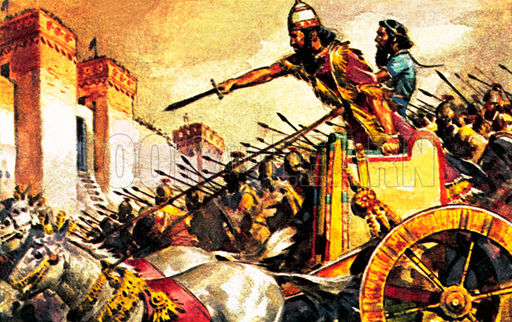The success of the Assyrian empire was not mere luck on the part of the Assyrian army. It was quite frankly anything but luck. They were considered the most efficient military force up until the time of their fall in 612 BCE. The Assyrians were known to be absolutely ruthless. Factors contributing to their success included their professionally trained army, their engineering skills, their well-developed tactics, and their all-important use of iron weaponry. Although use of iron for weaponry had already been capitalized on, the Assyrians are considered the first to take full advantage of the Iron Age.1
Previous to the use of iron, most weapons were made of bronze. Therefore, a majority of the Assyrians’ enemies were fighting with bronze weapons. The process for crafting these weapons out of iron required a quite different process than that of making bronze weapons. Iron, unlike bronze, needs to be heated and hammered. The Assyrians were lacking in resources and are believed to have been forced to master iron metallurgy rather quickly. Not only did making these weapons require new techniques, but also more time. Fortunately for the Assyrians, the use of iron increased the quality of armor as well as weaponry. While the use of iron made shields and helmets much heavier, it also allowed for greater protection.2

One of most notable weapons used by the Assyrians included the chariot. The chariot, originally a simple carriage drawn by donkeys, was introduced with horses by the Hyksos invaders of Egypt around 1700 BCE. The chariots were especially important for battlefield warfare because of their speed. Armor was most often worn by the chariot crews.3 Standard armor included a tightly fitted short sleeve jacket protecting the body and arms, as well as a loose skirt protecting the legs. The skirts were of different lengths; they could have been ankle length, thigh length, or slightly shorter. The full coat of armor was heavy, and for this reason, the armor was made into separate sections, making the weight better distributed.4 In addition to the body armor, Assyrians wore helmets of two types: pointed conical helmets and crested helmets.5
Often used by the Assyrians were daggers, which were different from what most would identify as a knife in that they have two cutting edges rather than one. Also used were swords. Similar to daggers, swords had two cutting edges, but were often larger in size. While a dagger was normally fourteen inches in length or less, a sword was often longer than twenty-eight inches. Remains of spearheads were found in more abundance than that of daggers and swords. Spearheads were essential to the Assyrian army. Spearmen served as the frontline troops in battle. While there are artificial remains of several different types of spearheads, they are nearly all made of iron.6
There is only a small quantity of artifacts from Assyrian military. Therefore, it is possible that part of the reason Assyrians were such a successful military force may remain a mystery. What can be said is that the Assyrians were militarily tactful, and masters of metallurgy. Eventually their lack of resources and size resulted in their fall; however, in history they will always be remembered as the strong, keen military force they were.
- Diana Haidar, “Assyrian Iron Working Technology and Civilization,” (Senior Thesis, The University Of Wisconsin Madison, 2011), 14–15. ↵
- World History Encyclopedia, January 2011, s.v., “Development Of Iron Arms And Armor,” by Tim J. Watts. ↵
- Salem Press Encyclopedia, January 2016, s.v. “Chariots in warfare,” by Elizabeth L. Meyers. ↵
- Amy E. Barron, “Late Assyrian Arms and Armour: Art Versus Artifact,” (Ph.D. Thesis, University of Toronto, Toronto, Canada, 2010), 168. ↵
- Amy E. Barron, “Late Assyrian Arms and Armour: Art Versus Artifact,” (Ph.D. Thesis, University of Toronto, Toronto, Canada, 2010), 179. ↵
- Amy E. Barron, “Late Assyrian Arms and Armour: Art Versus Artifact” (Ph.D. Thesis, University of Toronto, Toronto, Canada, 2010), 49, 79. ↵



35 comments
Daniel Matheu Baldor
I enjoyed reading this short, but well explained article. I found really interesting how Assyrians started making weapons of iron, which gave them an advantage against their enemies. I understand why enemies feared Assyrians, since they were ruthless, good strategists, using iron weaponry… I also enjoyed how in depth your article explains all the weapons they used, such as the knives, daggers and swords.
Diego Terrazas
Everyone feared the Assyrians, and it was probably for the best to not mess with them, well that is if they have not conquered you already. Their military tactics and metallurgy were most definitely their strong points when it came to warfare. The way they were armored is interesting to me. I wonder how they ran out of resources, given how many people they conquered.
Belene Cuellar
Its interesting to see how a group of strong individuals made what they had work out for the best. They were ruthless and fearless individuals who showed no mercy to their enemies. The resources that were available to them really made a difference to the battles that they fought. I had never even heard of the Assyrians until read this article and it offered me so much detail about how they used their weaponry.
Madison Downing
This article was very descriptive in explaining the armor and weapons of the Assyrians in history. I really appreciated how in depth you went in explaining the weapons they used, like daggers and swords, and why the Assyrians felt it was best to use them. Even thought they had a high lack of resources it’s great to see how they overcame their situation for as long as they could and didn’t fall without a good fight in the end.
Hailey Stewart
I didn’t know the difference between knives, daggers, and swords! This article was very explanatory, and was full of interesting facts. I find it odd that for such an innovative empire, their lack of resources was the key to their defeat. I now know what a lasting impression the Assyrians left in history.
Christopher Hohman
Nice article. The Assyrians sure were brutal. It is hard to imagine the things that they did especially uprooting families from their homes to keep their foes off balance. Just a terrible thing to do. I do however think the double sword idea is quite cool. Almost like a double bladed lightsaber in star wars. It must have made them very effective not to mention very imposing. Their adoption of Iron metallurgy was also really important. Most of their enemies were using bronze so it is a good thing for them that they had a technological advantage
Hector Garcia
This article on the Assyrians had a keen eye for detail. The information that the author used was able to describe the how the Assyrians were able to rise to the top. And how the lack of resources and men would lead to their demise. I thought that the article had great points on the way the Assyrians were able to gain power. I really appreciated the bits of the Assyrian army as well.
Caroline Bush
Interesting article! This article was very well detailed and I can tell that it was researched very well. Its Interesting how good warriors the Assyrians were and how they used their bronze weapons. I really enjoyed how you went over the different armors the Assyrians employed during there time. The Assyrians were defiantly the first of their kind and you could tell with how fierce they fought their battles. Overall I really enjoyed this article and found the topic to be very interesting.
Samuel Ruiz
As I was reading this, I could not help but to think of the Assyrians as the “mean, bad Assyrians.” It was nice to read about them as a smart and advanced army. I just read an article on the weapons of the Bronze Age, so it was nice to learn about a group known for the Iron Age. It is unfortunate that they fell apart due to their own size. Good job!
Raymond Davila
I had just recently read of the use of iron was what led to the Assyrians great success, but after reading this article i now believe that the use of iron was just a factor. The true reason for their success was the constant conflict during this time period and more specifically their technical skills like engineering and battle tactics that allowed them to face their enemies who had greater resources with an advantage.